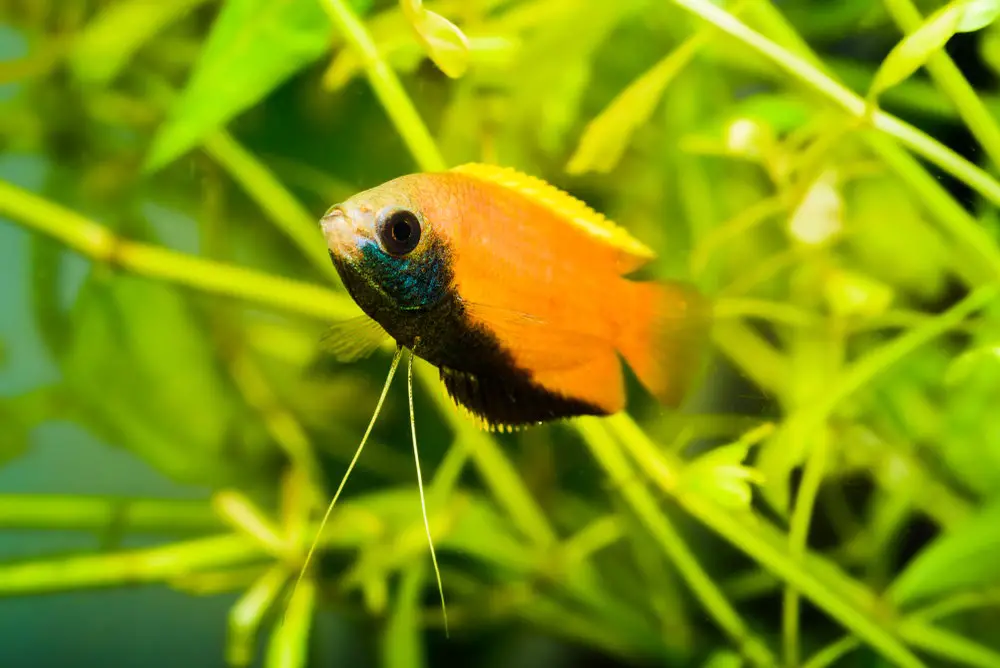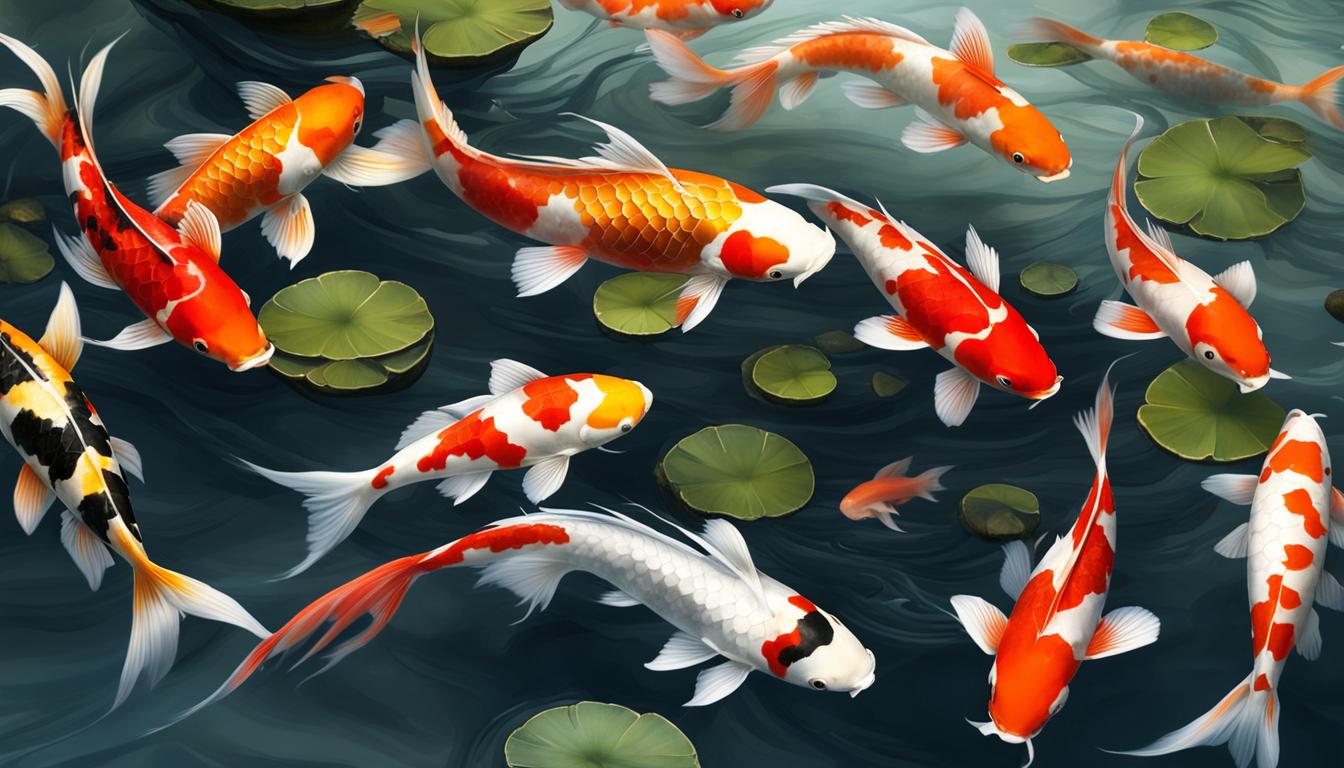Sunset Gourami, also known as Trichogaster chuna, is a freshwater fish with a splendid rusty orange or brown coloration accented by turquoise. It is similar to the honey gourami and is known by various common names like red flame gourami or red honey gourami.
These gouramis are easy to care for and have a lifespan of around 3-5 years. In their natural habitat, they feed on small bug larvae, crustaceans, and other invertebrates. However, in a home aquarium, they can be fed a diet of flakes, pellets, freeze-dried foods, and live foods.
They make great tank mates with other peaceful fish species like zebrafish, Cory catfish, and guppies.
Table of Contents
The Beauty Of Sunset Gourami
The stunning Sunset Gourami, also known as the red flame gourami or red honey gourami, is a beautiful freshwater fish native to Southern Myanmar. With its vibrant colors and peaceful temperament, this fish is a popular choice for aquarium enthusiasts.
Learn more about caring for and keeping Sunset Gouramis in our comprehensive guide.
Description Of The Vibrant Colors And Unique Features
- The Sunset Gourami is known for its mesmerizing array of vibrant colors. Its body boasts shades of yellow, orange, and golden, creating a stunning visual display.
- One of the most striking features of the Sunset Gourami is its beautifully patterned fins. The dorsal fin showcases a deep blue hue, while the pelvic fins glow in a fiery red shade.
- Along with its vivid colors, the Sunset Gourami has an elongated body, giving it an elegant appearance. Its slender shape is complemented by delicate, flowing fins, creating a graceful and captivating sight.
Natural Habitat And Behavior In The Wild
- Native to Southeast Asia, the Sunset Gourami is commonly found in slow-moving freshwater streams, ponds, and lakes. This species thrives in warm tropical climates with plenty of vegetation.
- In the wild, these gouramis are known to be peaceful creatures, often seen swimming among aquatic plants and searching for food. They are skilled jumpers, using their powerful tails to navigate through dense vegetation.
- Sunset Gouramis have a labyrinth organ, allowing them to breathe oxygen from the air. This adaptation enables them to survive in oxygen-deprived waters, such as shallow ponds during the dry season.
Why They Are Considered One Of The Most Beautiful Freshwater Fish
- The Sunset Gourami’s radiant coloration and unique features make it highly sought after in the aquarium trade. Its vibrant hues add a touch of exotic beauty to any freshwater tank.
- These gouramis are known for their peaceful temperament, making them suitable tank mates for various other species. Their calm nature and striking appearance make them a favorite among aquarists.
- The contrasting colors of the fins and body create a captivating visual display when the Sunset Gourami swims gracefully through the water. Its elegance and beauty have earned it the reputation of being one of the most stunning freshwater fish.
Care And Maintenance Of Sunset Gourami
When it comes to caring for sunset gouramis, proper maintenance is essential. These stunning freshwater fish require a well-maintained tank, appropriate tank mates, and a varied diet to thrive. Take care of your sunset gouramis by providing them with a suitable habitat, regular feeding, and a peaceful environment.
Sunset Gourami, also known as Sunset Honey Gourami or Red Flame Gourami, are beautiful and peaceful fish that can make a wonderful addition to your aquarium. To ensure their optimal health and well-being, it’s important to provide proper care and maintenance.
Here are some essential tips:
Tank Setup And Requirements For Sunset Gourami:
- Aquarium size: A 20-gallon tank or larger is recommended to provide ample space for Sunset Gourami to swim and explore.
- Filtration: Use a reliable filter to maintain clean and healthy water conditions. Gentle water flow is ideal as Gouramis prefer still or slow-moving water.
- Substrate: Provide a soft substrate like sand or fine gravel to mimic their natural habitat.
- Plants and hiding spots: Add live or artificial plants to create hiding spots and provide a natural feel. Floating plants can help diffuse lighting.
- Lighting: Moderate lighting is sufficient, and it’s best to provide areas of both shade and sunlight within the tank.
Water Parameters And Temperature For Optimal Health:
- PH level: Maintain a slightly acidic to neutral pH level between 6.0 and 7.5.
- Water temperature: Keep the water temperature between 75°F and 82°F (24°C – 28°C).
- Water hardness: Aim for a moderate water hardness level between 5-15 dGH.
- Water quality: Regularly test ammonia, nitrite, and nitrate levels to ensure they are within acceptable ranges. Perform regular water changes to keep water quality high.
Recommended Diet And Feeding Habits:
- Pellets and flakes: Provide a high-quality diet consisting of pellets and flakes specially formulated for Gouramis. Ensure the food is the appropriate size for their small mouths.
- Live and frozen foods: Supplement their diet with live or frozen foods like brine shrimp, daphnia, and bloodworms to provide variety and essential nutrients.
- Feeding frequency: Feed small amounts multiple times a day to mimic their natural feeding habits. Only provide what they can consume within a few minutes to prevent overeating and water pollution.
Tips For Maintaining A Clean And Healthy Tank Environment:
- Regular water changes: Perform weekly water changes of 20-30% to remove excess waste and maintain water quality.
- Proper maintenance: Clean the filter regularly and ensure it is functioning properly to keep the tank clean and the water free from toxins.
- Monitor water parameters: Test and monitor water parameters regularly to ensure they are within the appropriate range. Adjust as necessary to maintain optimal conditions.
- Avoid overstocking: Keep an eye on the number of fish in the tank and ensure it is not overcrowded, as this can lead to stress and poor water quality.
- Observation and care: Observe your Gouramis daily to spot any signs of illness or distress. Promptly address any issues by consulting with a knowledgeable aquatic specialist.
By following these care and maintenance tips, you can create a clean and healthy environment for your Sunset Gouramis to thrive in. Remember, their well-being is closely linked to the conditions of their habitat, so providing optimal care is essential for their overall health and longevity.
Compatibility And Tank Mates For Sunset Gourami
Sunset Gouramis, also known as red flame or red honey gouramis, make excellent tank mates. They are peaceful and can coexist with other small gouramis, such as honey, pearl, three spot, and sparkling gouramis, as well as zebrafish, cory catfish, harlequin rasbora, ember tetra, and guppies.
Sunset Gouramis, also known as Sunset Honey Gouramis, are beautiful and peaceful fish that can make a great addition to your community tank. However, it is important to choose their tank mates wisely to ensure a harmonious and stress-free environment for all the inhabitants.
Here are some factors to consider when selecting compatible fish species and tank mates for your Sunset Gourami:
Compatible Fish Species And Tank Mates For Sunset Gourami:
- Honey Gourami
- Pearl Gourami
- Three Spot Gourami
- Sparkling Gourami
- Zebrafish
- Cory Catfish
- Harlequin Rasbora
- Ember Tetra
- Guppy
Characteristics To Look For In Compatible Tank Mates:
- Peaceful temperament: Avoid aggressive or fin-nipping fish that may stress out the Sunset Gourami.
- Similar size: Opt for fish that are of a similar size to prevent any bullying or predation.
- Bottom-dwelling species: Choosing fish that occupy different areas of the tank can help minimize competition for territory and resources.
Potential Aggression And Territorial Behavior To Be Aware Of:
- Male Sunset Gouramis can display territorial behavior towards each other, especially during breeding season. It is recommended to keep only one male Sunset Gourami per tank unless the tank is significantly large.
- Some male Gouramis may exhibit aggression towards other fish with long, flowing fins. Keep an eye on their behavior during the initial introduction to ensure compatibility.
Ideal Tank Size And Setup For A Peaceful Community Tank With Sunset Gourami:
- Tank size: A minimum tank size of 20 gallons is recommended for a single Sunset Gourami. If you plan to keep multiple Gouramis or other fish, consider a larger tank to provide ample swimming space.
- Tank setup: Creating a well-planted tank with plenty of hiding spots and floating plants can help establish territories and provide a peaceful environment for the fish. Adding driftwood or rocks can also provide additional hiding spots and a natural aesthetic.
Remember to monitor your tank inhabitants regularly and be prepared to make adjustments if any compatibility or aggression issues arise. By selecting compatible tank mates and providing a suitable environment, you can enjoy the vibrant beauty and peaceful nature of Sunset Gouramis in your community tank.
Breeding And Reproduction Of Sunset Gourami
The Sunset Gourami, also known as the Red Flame Gourami or Red Honey Gourami, is a freshwater fish species that requires careful breeding and reproduction. With its vibrant colors and ease of care, it is a popular choice for aquarium enthusiasts.
Breeding Behavior And Requirements For Sunset Gourami:
Sunset Gouramis, also known as red honey gouramis, can be a delightful addition to any aquarium. If you’re interested in breeding these beautiful fish, there are a few things you should know about their breeding behavior and requirements. Here are some key points to consider:
- Breeding behavior:
- Sunset Gouramis are bubble nest builders and exhibit courtship rituals before mating.
- Males build large bubble nests at the surface of the water to entice females to lay their eggs.
- During courtship, the male will display vibrant colors and perform intricate dances to attract the female.
- Requirements for breeding:
- The tank should be spacious with plenty of hiding places and live plants for the fish to feel secure.
- The water temperature should be maintained between 78-82°F (25-28°C).
- The pH level should be around 6.0-7.0, with a slightly acidic to neutral water condition.
- It’s important to keep the water clean and well-maintained to ensure a healthy breeding environment.
Setting Up A Breeding Tank And Providing The Right Conditions:
Creating the perfect breeding tank for Sunset Gouramis is crucial to their successful reproduction. Here are some guidelines for setting up a breeding tank and providing the right conditions:
- Tank setup:
- Use a separate breeding tank, preferably a larger one to provide ample space for the fish to roam.
- Incorporate live plants, floating or submerged, as they act as hiding spots for the female and provide surfaces for the male to build his bubble nest.
- Water conditions:
- Maintain a stable water temperature between 78-82°F (25-28°C) using a reliable aquarium heater.
- Keep the pH level slightly acidic to neutral, around 6.0-7.0, by monitoring and adjusting as necessary.
- Conduct regular water changes to ensure optimal water quality and cleanliness.
- Nest preparation:
- Provide floating plants like Indian fern or Amazon frogbit. These plants will provide the necessary support for the bubble nest.
- Dim the tank’s lighting to mimic dusk or dawn, as this stimulates breeding behavior in Sunset Gouramis.
- The male will construct the bubble nest beneath the floating plants once he is ready to breed.
Caring For The Eggs And Fry During The Breeding Process:
Once the female has laid her eggs and the male has fertilized them, it is crucial to provide proper care for the eggs and fry throughout the breeding process. Here are some essential tips for their care:
- Egg care:
- After the eggs are laid, the male will guard the nest and ensure that fallen eggs are collected and returned to the nest.
- Remove any uneaten eggs that turn white or develop fungus to prevent contamination.
- Fry care:
- Once the fry hatch, they will stay near the bubble nest. The male will protect them and periodically move them into safer areas.
- Feed the fry with infusoria or commercial fry food designed for small fish.
- Maintain good water quality and perform regular water changes to keep the fry healthy.
- Separation:
- When the fry reach a size of approximately 1 inch, it’s advisable to separate them into their own tank to prevent aggression and cannibalism.
Tips For Successfully Breeding And Raising Sunset Gourami:
Breeding Sunset Gouramis can be a rewarding experience. Here are some additional tips to increase your chances of success:
- Patience is key: Give the fish time to establish their social hierarchy and courtship rituals.
- Quality diet: Provide a varied and nutritious diet, including live or frozen foods, to keep the fish healthy and ready for breeding.
- Maintain water quality: Regularly test the water parameters and perform necessary water changes to ensure a stable and clean environment.
- Monitor behavior: Observe the fish closely for signs of aggression or stress and address any issues promptly.
Remember, breeding fish requires experience and dedication. With the right conditions and attentive care, you can enjoy the wonder of raising Sunset Gouramis and witnessing their beautiful courtship and breeding behavior firsthand.
Common Health Issues And Diseases In Sunset Gourami
Sunset Gourami, also known as the red flame or red honey gourami, are freshwater fish found in the rivers and ponds of Southern Myanmar. They are prone to common health issues and diseases, making proper care and maintenance essential for their well-being.
Common Diseases And Health Issues That Can Affect Sunset Gourami:
Sunset Gourami, like any other fish, are susceptible to certain health issues and diseases. It is important for fish keepers to be aware of these common problems in order to provide the necessary care and treatment. Here are some of the most common diseases and health issues that can affect Sunset Gourami:
- Ich (Ichthyophthirius multifiliis): This is a common parasitic disease that causes white spots on the fish’s body and fins. It can be treated with the use of medications and by maintaining good water quality.
- Fin Rot: This is a bacterial infection that affects the fish’s fins, causing them to deteriorate and fray. It is important to identify and treat fin rot early to prevent further damage to the fish’s fins.
- Velvet Disease (Oodinium): This is another parasitic disease that causes the fish’s body to appear coated in a golden or rusty dust. Infected fish may also exhibit rapid breathing and flashing behavior. Treatment options include medications and improving water quality.
- Dropsy: Dropsy is a condition where the fish’s body becomes bloated due to fluid retention. It is often caused by a bacterial infection and can be fatal if left untreated. Medications and water parameter adjustments may be used to treat dropsy.
- Swim Bladder Disorder: This disorder affects the fish’s ability to regulate its buoyancy and swim properly. It can be caused by various factors, including poor water quality, overfeeding, or injury. Treatment may involve fasting the fish and improving water conditions.
Recognizing The Signs Of Illness And Disease In Sunset Gourami:
It is important for fish keepers to be able to recognize the signs of illness and disease in Sunset Gourami. By being observant and proactive, you can provide the necessary care and treatment to your fish. Here are some common signs of illness and disease to watch out for:
- Changes in behavior: Notice if your fish is lethargic, hiding, or exhibiting unusual swimming patterns. These can be signs of an underlying health issue.
- Loss of appetite: If your fish is not eating as usual or completely avoiding food, it may indicate a problem.
- Physical abnormalities: Look out for any visible signs such as discoloration, sores, fin deterioration, or bloating.
- Rapid breathing or gasping: Labored breathing or frequent gasping at the water’s surface can be a sign of respiratory issues or poor water quality.
- Erratic swimming: If your fish is swimming abnormally, such as tilting to one side or having difficulty staying upright, it may indicate a swim bladder issue.
Prevention And Treatment Methods For Maintaining Good Fish Health:
Preventing and treating diseases in Sunset Gourami involves a combination of proactive measures and proper care. By following these prevention and treatment methods, you can maintain good fish health:
- Maintaining good water quality: Regularly test and monitor the water parameters, such as temperature, pH, ammonia, nitrite, and nitrate levels. Ensure proper filtration and regular water changes to keep the tank environment clean and healthy.
- Quarantine new fish: Before introducing new fish to your tank, quarantine them in a separate tank for a period of time to monitor for any signs of illness. This helps to prevent the spread of diseases to existing fish.
- Balanced diet: Provide a balanced diet for your Sunset Gourami, including a variety of high-quality commercial fish foods as well as occasional live or frozen foods. Ensure proper feeding amounts to avoid overfeeding.
- Clean environment: Regularly clean the tank and remove any uneaten food, debris, or dead plant matter to prevent the buildup of waste that can contribute to poor water quality and stress.
- Medications: If your fish does become ill, consult with a veterinarian or experienced fish keeper to determine the appropriate medication or treatment. Follow the instructions carefully and monitor the fish’s progress.
By following these prevention and treatment methods, you can help maintain good fish health and reduce the risk of diseases in your Sunset Gourami. Regular observation, proper care, and prompt action can go a long way in ensuring the well-being of your fish.
Frequently Asked Questions About Sunset Gourami
Discover everything you need to know about Sunset Gourami in this comprehensive FAQ guide. Learn about their lifespan, tank mates, diet, and more to ensure the best care for these beautiful fish.
What Is The Lifespan Of Sunset Gourami?
Sunset Gourami has an average lifespan of 4 to 6 years with proper care and a suitable environment.
- They can live longer with proper care, such as providing a nutritious diet and maintaining optimal water conditions.
- Factors like genetics, water quality, and diet can affect the lifespan of Sunset Gouramis.
- Regular water changes and monitoring water parameters are crucial to ensuring their longevity.
Do Sunset Gourami Require Any Special Care Or Attention?
Yes, Sunset Gouramis require some special care and attention to thrive in captivity.
- Providing a spacious tank with plenty of hiding spots, plants, and floating vegetation will help create a comfortable environment for them.
- Maintaining a stable water temperature between 76-82°F is important for their well-being.
- Regular water changes and filtration are essential to keep the water clean and free of toxins.
- They prefer slightly acidic to neutral water with a pH range of 6.0-7.5.
- Offering a varied diet including high-quality flakes, pellets, live or frozen foods will ensure they receive the necessary nutrients.
Can Sunset Gourami Be Kept With Other Fish Species?
Yes, Sunset Gouramis can be kept with various fish species, but careful consideration should be given to their temperament and compatibility.
- Peaceful community fish such as zebrafish, cory catfish, harlequin rasbora, ember tetra, and guppies are generally suitable tank mates for Sunset Gouramis.
- Avoid keeping them with aggressive or fin-nipping fish as this may cause stress and harm to the Sunset Gouramis.
- Introducing tank mates of a similar size and temperament will help prevent any potential conflicts.
How To Enhance The Colors Of Sunset Gourami?
There are several ways to enhance the colors of Sunset Gouramis and bring out their vibrant appearance.
- Providing a well-balanced diet rich in carotenoids can help intensify their colors. Look for fish foods that contain ingredients like spirulina, krill, and astaxanthin.
- Keeping the water quality optimal and maintaining stable water parameters can have a positive impact on their colors.
- Supplementing their diet with occasional live or frozen foods like bloodworms, brine shrimp, and daphnia can provide additional nutrients and stimulate their natural feeding behaviors.
- Adequate lighting in the tank can also enhance the colors of their scales and make them more visually striking.
Remember, each Sunset Gourami is unique, and their colors may vary depending on genetics and individual factors. Paying attention to their overall health and providing a suitable environment will help ensure they display their best colors.
Frequently Asked Questions For Sunset Gourami
How Big Do Sunset Gouramis Get?
Sunset gouramis typically grow to a size of about 3 to 4 inches.
Are Sunset And Honey Gourami The Same?
No, sunset and honey gourami are not the same. They are different names for the same fish, also known as red flame gourami.
What Is The Lifespan Of A Sunset Honey Gourami?
The sunset honey gourami has a lifespan of approximately 3 to 5 years.
What Do Sunset Gouramis Eat?
Sunset gouramis eat small bug larvae, crustaceans, and other invertebrates. They can also eat flakes, pellets, gel food, freeze-dried foods, frozen foods, and live foods.
Conclusion
The Sunset Gourami, also known as the Sunset Honey Gourami, is a stunning freshwater fish that is easy to care for and adds beauty to any aquarium. With its rusty orange or brown coloration and turquoise fins with orange or pink edges, it is a visually striking addition to your tank.
This fish is a peaceful and social species, making it a great choice for community aquariums. When it comes to diet, Sunset Gouramis are not picky eaters. They will happily consume flakes, pellets, gel food, freeze-dried and frozen foods, as well as live foods.
Providing them with a varied diet ensures their optimal health and well-being. In terms of tank size requirements, a larger tank with plenty of vegetation and hiding spaces is recommended, as this helps replicate their natural habitat. Additionally, Sunset Gouramis coexist well with tank mates such as Sparkling Gouramis, Zebrafish, Cory Catfish, Harlequin Rasboras, Ember Tetras, and Guppies.
Overall, the Sunset Gourami is a beautiful and low-maintenance fish that can thrive in the right environment. Consider adding this eye-catching species to your aquarium to enhance its visual appeal and create a peaceful and harmonious community for your other fish.
I am a passionate aquarist with over 30 years of hands-on experience in fishkeeping. My journey began at a young age, collecting fish from the wild and learning through experimentation. Specializing in tropical fish, I bring a deep understanding of the hobby to FishKeepingMadeSimple. The site provides honest, detailed reviews of essential products and accessories to help fellow enthusiasts create the best environments for their fish.













